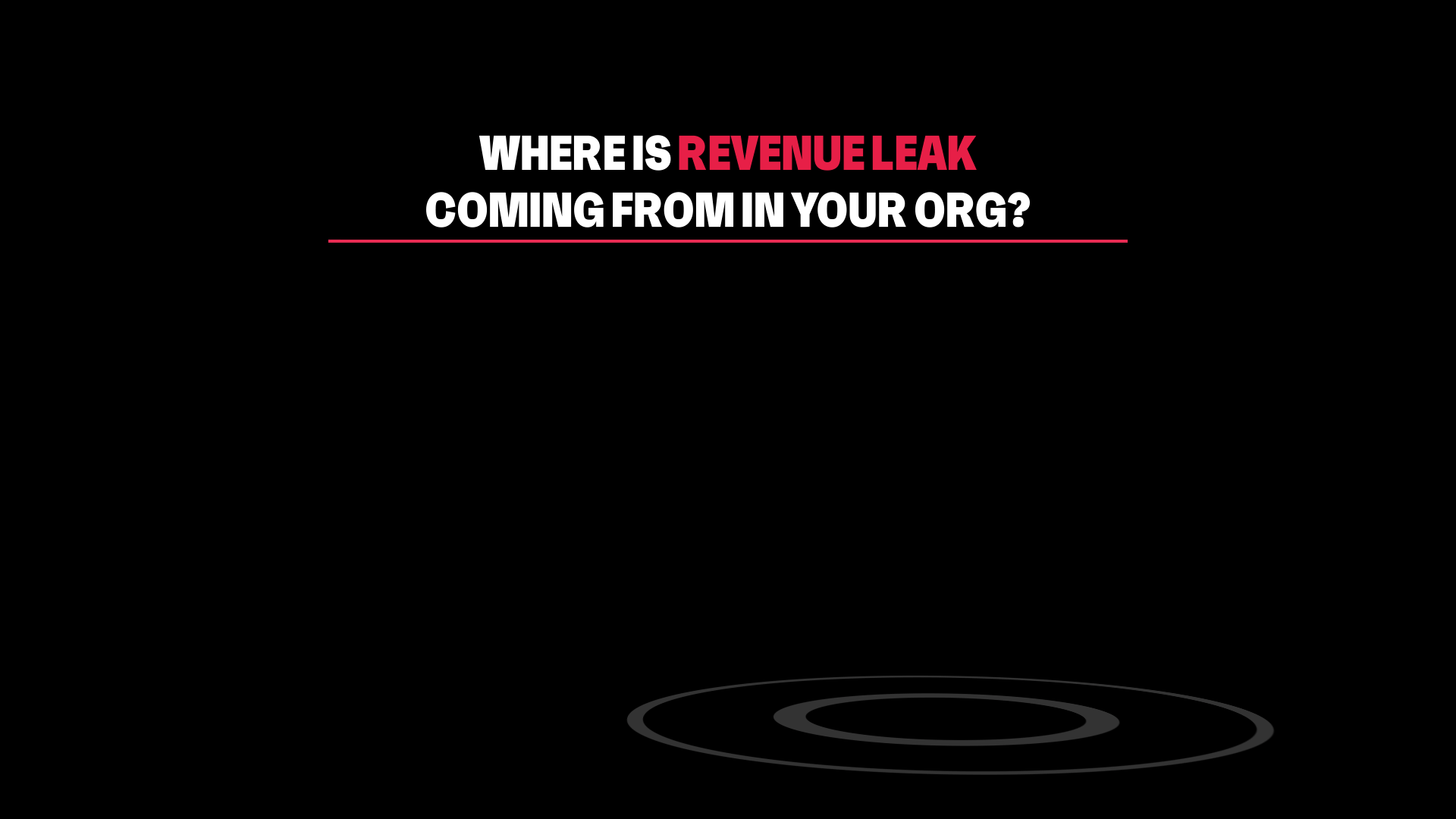Imagine you have a leak but don’t know how big it is or where it’s coming from.
Hard to fix and frustrating. It seeps into other parts of your house, damaging everything it touches.
So you open up the walls and uncover a mess.
You were not ready, nor prepared.
Revenue leak is similar. But instead of water, it’s money. Instead of walls, it’s your revenue team.

And if you are not thinking about how to prevent it today, you’re putting your targets and business at considerable risk.
Revenue leak is revenue earned or counted on earning but not captured. Leaks can happen because of deal slippage, inaccurate billing, bad data, manual processes prone to human error, or unbilled services or products (to name a few).
The good news is revenue leak is preventable...with sales readiness. Too often, the effort it requires to ensure the proper tools, processes, and people are in place prior to launching a new product or service is underestimated. When it’s realized, it’s already too late.
Enter revenue leak.
A competent and efficient sales team is essential for any organization looking to thrive. It’s not enough to excel. Businesses need to ensure their sales teams are well-prepared. That “readiness” means more than just tools and technology.
This article will dive into sales readiness, explore its three core components, discuss the differences between sales readiness and sales enablement, and finally, close with how revenue readiness brings it all home.
Let’s start with a definition.
What is Sales Readiness?
Sales readiness is the level at which a sales organization is fully prepared to move as one...to engage effectively with prospects and customers...to be armed with the right skills, knowledge, and tools to close deals and develop long-term partnerships.
Teams must be fully equipped to execute every aspect of the entire sales lifecycle—from prospecting to discovery to demo to closed deals.
This holistic approach to sales preparedness requires a focus on three crucial areas: (1) product training, (2) marketing training, and (3) pipeline development.
-
Product Training is the foundation of sales readiness—educating the sales team on the company's offerings, its unique value propositions, and the specific problems they solve for customers.
More than anyone else in the organization, sales reps must be the subject matter experts on the product or service they are selling. This crystal clear understanding translates directly to customers who will feed off that knowledge and expertise and have confidence throughout the sales process.
-
Market Training equips the sales team with the right messaging, positioning, and promotional strategies that align with the company's marketing initiatives. In addition, proper market training empowers the sales team to be experts in the current market and the competition within their industry.
• Understanding the target audience
• Being well-versed in all buyer personas
• Being up-to-date on the ever-changing competitive landscape
• Having a deep knowledge of competitors’ features—what’s similar, unique, etc.
Practical market training enables sales professionals to capitalize on marketing-generated leads, leverage sales decks, use battle cards and one-sheets effectively, and have objection handling nailed.
-
Pipeline development is the process of identifying, nurturing, and managing an ongoing stream of (ideally, qualified) leads for sales.
Pipeline development must be (a) clearly established and (b) 100% understood by the entire sales team. Any gap in understanding or execution will inevitably result in deal slippage.
Obviously, there is too much at stake to rely on manual processes. Smarter organizations streamline the entire pipeline process using revenue automation platforms supported by crucial marketing and operations management system integrations.
Wait. Isn’t this just sales enablement? Same same?
What’s the difference between sales readiness and sales enablement?
Sales organizations often confuse sales readiness with sales enablement.
While sales readiness and enablement share the goal of improving sales performance, they differ in focus and approach.
Sales enablement is a broader concept encompassing strategies, tools, and resources designed to support the sales team's daily activities—customer relationship management (CRM), content management systems (CMS), sales playbooks, content libraries, and so on.
Sales enablement can also leverage sophisticated resources like Clari’s Align (mutual action plans and buyer collaboration) and Wingman (revenue conversation intelligence and coaching). These products help teams effectively engage with qualified prospects, build relationships, and drive revenue growth.
On the other hand, sales readiness focuses on preparing the sales force with the specific skills, knowledge, and capabilities needed to engage effectively with prospects and customers. It is an ongoing process of ensuring that the sales team is consistently equipped to perform at their best, adapt to changing market conditions, and drive revenue growth.
Interested in more? We did a deep dive here.
Moving from sales readiness to revenue readiness
Revenue readiness is the next level in the sales preparedness journey.
Revenue readiness is a comprehensive approach: Sales readiness plus other revenue-generating functions within the organization—customer success, support, and account management.
Revenue readiness aims to align all revenue-generating functions to work in harmony, ensuring a seamless and consistent customer experience across the entire buyer journey. This holistic approach drives customer satisfaction, retention, and revenue growth — the one thing we are all seeking.
Revenue readiness is the first step to achieving full revenue maturity, a significant milestone in Clari’s RevCG (Revenue Collaboration and Governance) matrix.
Wait. Governance? I thought we were talking about revenue.
While many think of governance as something that applies strictly to data or other technical resources, governance must also apply to revenue. Just as improved data governance can lead to security breaches, improper revenue governance can lead to financial hazards. It is paramount that stakeholders from all business units collaborate on a sound revenue governance framework to protect the organization's financial resources.
Once an organization’s revenue readiness level reaches its maximum potential—thanks to a dialed-in revenue collaboration and governance program—revenue leak moves closer towards revenue precision, the total capture of revenue predictably and repeatedly.
Where does your organization fall on the Clari RevCG matrix?


